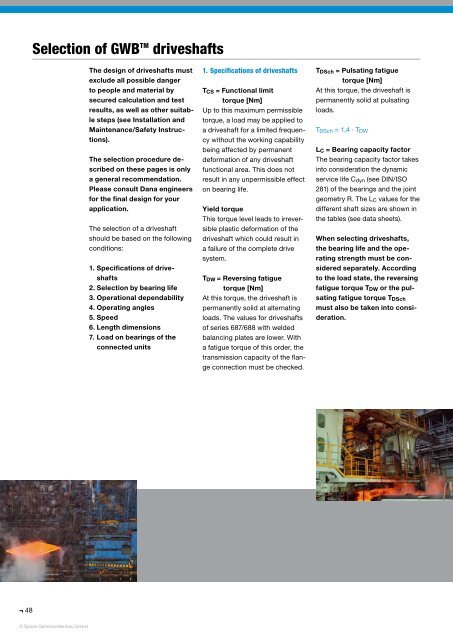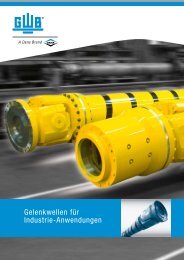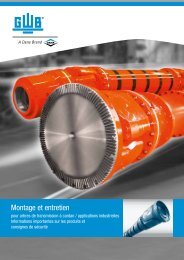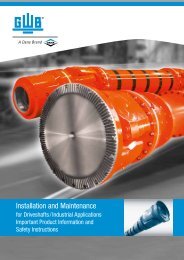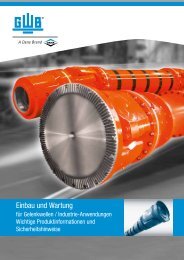Driveshafts for Industrial Applications - GWB
Driveshafts for Industrial Applications - GWB
Driveshafts for Industrial Applications - GWB
Create successful ePaper yourself
Turn your PDF publications into a flip-book with our unique Google optimized e-Paper software.
Selection of <strong>GWB</strong> TM driveshafts<br />
The design of driveshafts must<br />
exclude all possible danger<br />
to people and material by<br />
secured calculation and test<br />
results, as well as other suitable<br />
steps (see Installation and<br />
Maintenance/Safety Instructions).<br />
The selection procedure described<br />
on these pages is only<br />
a general recommendation.<br />
Please consult Dana engineers<br />
<strong>for</strong> the final design <strong>for</strong> your<br />
application.<br />
The selection of a driveshaft<br />
should be based on the following<br />
conditions:<br />
1. Specifications of driveshafts<br />
2. Selection by bearing life<br />
3. Operational dependability<br />
4. Operating angles<br />
5. Speed<br />
6. Length dimensions<br />
7. Load on bearings of the<br />
connected units<br />
1. Specifications of driveshafts<br />
T CS = Functional limit<br />
torque [Nm]<br />
Up to this maximum permissible<br />
torque, a load may be applied to<br />
a driveshaft <strong>for</strong> a limited frequency<br />
without the working capability<br />
being affected by permanent<br />
de<strong>for</strong>mation of any driveshaft<br />
functional area. This does not<br />
result in any unpermissible effect<br />
on bearing life.<br />
Yield torque<br />
This torque level leads to irreversible<br />
plastic de<strong>for</strong>mation of the<br />
driveshaft which could result in<br />
a failure of the complete drive<br />
system.<br />
T DW = Reversing fatigue<br />
torque [Nm]<br />
At this torque, the driveshaft is<br />
permanently solid at alternating<br />
loads. The values <strong>for</strong> driveshafts<br />
of series 687/688 with welded<br />
balancing plates are lower. With<br />
a fatigue torque of this order, the<br />
transmission capacity of the flange<br />
connection must be checked.<br />
T DSch = Pulsating fatigue<br />
torque [Nm]<br />
At this torque, the driveshaft is<br />
permanently solid at pulsating<br />
loads.<br />
T DSch = 1,4 · T DW<br />
L C = Bearing capacity factor<br />
The bearing capacity factor takes<br />
into consideration the dynamic<br />
service life C dyn (see DIN/ISO<br />
281) of the bearings and the joint<br />
geometry R. The L C values <strong>for</strong> the<br />
different shaft sizes are shown in<br />
the tables (see data sheets).<br />
When selecting driveshafts,<br />
the bearing life and the operating<br />
strength must be considered<br />
separately. According<br />
to the load state, the reversing<br />
fatigue torque T DW or the pulsating<br />
fatigue torque T DSch<br />
must also be taken into consideration.<br />
48<br />
© Spicer Gelenkwellenbau GmbH


